
April is Child Abuse Prevention Month, and OJJDP's Child Protection Division staff will participate in national conferences on child abuse prevention and juvenile justice issues to discuss OJJDP's efforts to protect children and offer services to system-involved youth.
 The U.S. Department of Health and Human Services is sponsoring the 17th National Conference on Child Abuse and Neglect in Atlanta, GA, March 30–April 4, 2009. On April 1, during the session "Addressing Exposure to Violence as a Prevention of Child Abuse and Neglect Strategy," OJJDP staff will discuss how the Safe Start Initiative decreases risks and increases protective factors for children exposed to violence in their homes and communities.
The U.S. Department of Health and Human Services is sponsoring the 17th National Conference on Child Abuse and Neglect in Atlanta, GA, March 30–April 4, 2009. On April 1, during the session "Addressing Exposure to Violence as a Prevention of Child Abuse and Neglect Strategy," OJJDP staff will discuss how the Safe Start Initiative decreases risks and increases protective factors for children exposed to violence in their homes and communities.
The associate administrator of the Child Protection Division will speak at the OJJDP's National Children's Advocacy Center in Huntsville, AL, March 23–26. For more information about children's advocacy centers, please visit OJJDP's Web site and read the OJJDP Bulletin Evaluating Children's Advocacy Centers' Response to Child Sexual Abuse, released in August 2008.
 OJJDP staff will present information on the OJJDP-sponsored court coordination program (CCP) at the National Council of Juvenile and Family Court Judges. CCP helps system-involved youth receive the services they need to improve their lives. For more information on CCP, please see the story "OJJDP's Court Coordination Program Promotes the Delivery of Services to Children in Need" in the November/December 2008 issue of News @ a Glance.
OJJDP staff will present information on the OJJDP-sponsored court coordination program (CCP) at the National Council of Juvenile and Family Court Judges. CCP helps system-involved youth receive the services they need to improve their lives. For more information on CCP, please see the story "OJJDP's Court Coordination Program Promotes the Delivery of Services to Children in Need" in the November/December 2008 issue of News @ a Glance.

Laurie Robinson, Acting Assistant Attorney General for the Office of Justice Programs (OJP), has reported that OJP will receive more than $2.76 billion under the American Recovery and Reinvestment Act of 2009 (Recovery Act), which includes $147.5 million to be administered by OJJDP.
Assistance available through the Recovery Act will include the following:
- $2 billion for the Edward Byrne Memorial Justice Assistance Grant Program to support a broad range of activities to prevent and control crime and improve the criminal justice system.
- $225 million for the Edward Byrne Competitive Grant Program to help communities address targeted needs. This includes $97.5 million for mentoring initiatives to be administered by OJJDP.
- $225 million for assistance to tribal law enforcement (construction of jails on tribal lands).
- $125 million for rural law enforcement to prevent and combat drug-related crime.
- $30 million for law enforcement along the Southern Border and in High Intensity Drug Trafficking Areas.
- $50 million for Internet Crimes Against Children (ICAC) initiatives.
- $100 million for victim compensation and assistance.
Resources:
For additional information about OJP funding under the Recovery Act, visit www.ojp.usdoj.gov/recovery.
Information about OJJDP funding is available at www.ojjdp.ncjrs.gov/recoveryact.html.
Additional information about the impact of the Recovery Act on ICAC, mentoring, and other youth-related programs, including solicitation announcements, will be posted on OJJDP's Web site as it becomes available.
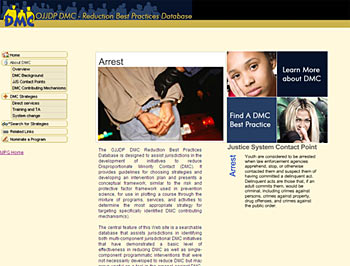
The DMC-Reduction Best Practices Database provides access to strategies for DMC coordinators seeking to implement proven methods for reducing DMC in their State.
DMC Coordinator Training
OJJDP's State Relations and Assistance Division (SRAD) held a New DMC Coordinator Training January 12–13 for coordinators from Maryland, West Virginia, and Mississippi at the OJJDP offices in Washington, DC. The trainers used the five-phase DMC-reduction model and offered step-by-step assistance in implementing each phase of the model according to each State's specific circumstances. The Office will hold additional trainings for five new DMC coordinators in April and will continue to offer these trainings as requested. States interested in attending new DMC coordinator trainings can contact OJJDP's State representative/DMC Team Lead Andrea Coleman at [email protected].
SRAD National Training Conference To Include DMC Training
The four requirements of the JJDP Act are reducing DMC, deinstitutionalization of status offenders, sight and sound separation, and jail removal. SRAD's annual conference, which will be held September 28–October 1 in Austin, TX, will feature sessions on all four requirements of the Act, including DMC. The conference will provide juvenile justice specialists, DMC coordinators, compliance monitors, and State Advisory Group members the opportunity to network and share information and success stories.
DMC Technical Assistance Manual To Be Updated This Spring
The online DMC Technical Assistance Manual, 3rd Edition will be updated and expanded this spring to address topics of importance to DMC coordinators. The chapter on identification of DMC will be expanded to include more detailed information on how to measure the full extent of DMC. One new chapter will describe the additional roles and responsibilities of DMC coordinators, and another new chapter will address efforts to reduce DMC among Hispanic youth, particularly with regard to improving delinquency prevention activities in Nevada and Texas.
Upcoming DMC Bulletin
Reducing DMC: Preparation at the Local Level is an upcoming OJJDP Bulletin that details how communities can effectively reduce DMC. Drawing largely from the Disproportionate Minority Contact Technical Assistance Manual, 3rd Edition, the Bulletin provides background information on DMC in communities and a six-step preparation process for initiating a DMC-reduction effort. The Bulletin highlights the importance of preparation activities, finding a sustainable source of funding, establishing a steering committee, organizing goals and tasks, and conducting interventions. The Bulletin also describes the Juvenile Detention Alternatives Initiative Core Strategies Matrix, which provides communities a structured, content-specific method to examine their detention policies, practices, and programs and to gauge their progress toward achieving detention reform.
OJJDP sponsors the Nation's most comprehensive data collection program on juvenile offenders in custody and the facilities that hold them. Through a constellation of surveys—which include the Survey of Youth in Residential Placement (SYRP), the Census of Juveniles in Residential Placement (CJRP), and the Juvenile Residential Facility Census (JRFC)—the agency provides critical information to State and national researchers and policymakers who are investigating and seeking answers to major policy and practice questions affecting youth in residential placement, and disseminating those findings to the field. While CJRP and JRFC gather critical data from residential facility administrators, SYRP interviews juveniles, providing an unprecedented inside look at their experiences in custody. By directly questioning youth, SYRP addresses issues that no other information source covers.
This spring, OJJDP will officially release the results of SYRP interviews conducted in 2003. The results are expected to provide policymakers with a richly textured view of the family histories of juveniles in custody, how juveniles experience confinement, and how facility structure and operations may affect those experiences.
SYRP is the most recent addition to OJJDP's multitiered data-collection effort. SYRP targets offender youth ages 10–20 in facilities surveyed for CJRP and JRFC, drawing a nationally representative sample of more than 7,000 youth from this population. The survey addresses both pre- and postadjuducation youth and facilities. Using computer-assisted self-interviews, SYRP asks youth about their backgrounds, offense histories, and problems; the facility environment; their experiences in the facility; and their expectations for the future.
The SYRP interview data are limited to facility-level administrative data, including the structure, characteristics, capacity, security, and services of the facility. More than 200 facilities participated in SYRP.
The results identify a set of factors, each of which predicts a youth's risk of violence in the context of the other factors, detailing a broad set of characteristics, circumstances, and conditions that operate independently to elevate the risk of violence. These findings offer valuable guidance to the field because policy and practices can modify many of the strong risk factors.
Following is a preview of a few of the researchers' findings:
- Less than one-half of the juveniles surveyed had two parents taking care of them when they were growing up. Forty-two percent had one parent taking care of them, and 11 percent had no parent.
- Twenty-two percent of males and 13 percent of females either have children or are expecting a child.
- Nineteen percent say they are a member of a gang in the facility, 75 percent say there are fights in their facility, and 32 percent have been personally involved in fights.
- Seventeen percent report that while in custody they have been beaten up and injured, their property was taken directly by force or threat, and/or they were forced to engage in sexual activity.
- Twenty percent have 2–9 roommates while in custody, and 17 percent have 10 or more roommates. Thirty-four percent often or always have difficulty falling asleep.
- Thirty-seven percent of the youth had either recent suicidal thoughts or feelings or a past suicide attempt. Fifty-three percent of youth in custody have seen a counselor in their current facility to discuss emotional problems.
- Thirty-five percent say staff use unnecessary force, and 59 percent experienced some form of coercive control (e.g., strip searched, put into handcuffs, sprayed with pepper spray).
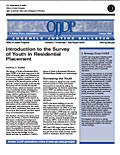
Following the general structure of the survey design, other Bulletins describe research in each of the survey's topic areas:
- Survey of Youth in Residential Placement: Youth's Characteristics, Backgrounds, and Expectations summarizes current offenses and youth's previous involvement in the juvenile justice system, and provides data on offenders' family backgrounds.
- Survey of Youth in Residential Placement: Conditions of Confinement describes the physical features of juvenile facilities, rates the quality of available programs, and reports on the access to various social, emotional, and legal supports at the facilities.
- Survey of Youth in Residential Placement: Youth's Needs and Services They Receive in Custody includes questions about recent mental and emotional symptoms, experiences associated with emotional problems, and available treatment for such problems.
- Survey of Youth in Residential Placement: Nature and Risk of Victimization in Residential Placement provides information on the percentages of youth who report victimization experiences while in custody including theft, robbery, physical assault or threat, or sexual assault, and how these problems were addressed.
- Survey of Youth in Residential Placement: Highlights of the Survey of Youth in Residential Placement presents an overview and summary of the most important aspects of the information gleaned from the survey.
Release of the above Bulletins will be highlighted in future issues of News @ a Glance and JUVJUST.
In addition to supporting the development and enhancement of juvenile drug court programs across the Nation, OJJDP plays an active role in educating and training juvenile justice professionals and disseminating the latest information about juvenile drug courts to the field. Some recent activities include drug court trainings and speaking appearances by OJJDP staff at related conferences.
Juvenile Drug Court Training
OJJDP recently sponsored two trainings to help communities maximize the effectiveness of juvenile drug courts. The trainings, entitled "Enhancing Your Juvenile Drug Court: Moving Your Juvenile Drug Court From Where It Is...To Where You Want It To Be!" were held January 20–23 in Dallas, TX, and February 2–5 in Louisville, KY. The trainings were designed to help attendees assess current practices, enhance the continuum of care for juvenile drug court clients, discuss practical solutions to ongoing challenges, provide current information on critical topics, and bring teams together for valuable networking opportunities. The attendees included judges, coordinators, prosecutors, defense attorneys, probation officers, substance abuse treatment counselors, school partners, and case managers.
Community Anti-Drug Coalitions of America Conference

OJJDP's Deputy Administrator for Programs Marilyn Roberts addressed the SMART System, and the Office's Model Programs Guide.
All OJJDP publications may be viewed and downloaded on the publications section of the OJJDP Web site. Print publications also may be ordered online at the National Criminal Justice Reference Service (NCJRS) Web site.
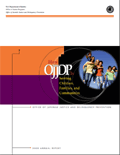 OJJDP 2008 Annual Report (NCJ 225036)
OJJDP 2008 Annual Report (NCJ 225036)
This congressionally mandated report summarizes OJJDP's research and program activities in fiscal year 2008 to promote early intervention and delinquency prevention, support faith-based and community organizations, expand mentoring, improve the juvenile justice system, ensure public safety, curb child exploitation, combat youth gangs, and serve tribal youth. The report, which was delivered to Congress on March 23, concludes with an overview of the Office's information dissemination efforts.
To order a printed copy of the report, please visit the NCJRS Web site.
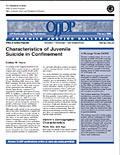 Characteristics of Juvenile Suicide in Confinement (NCJ 214434)
Characteristics of Juvenile Suicide in Confinement (NCJ 214434)
This Bulletin summarizes the findings of the first national survey ever conducted on juvenile suicides in confinement. The OJJDP-funded survey, conducted by the National Center on Institutions and Alternatives, gathered detailed data on each suicide victim, suicide incident, and juvenile facility in which the suicide occurred. Among the survey's findings: More than two-thirds of the victims were white, more than three-quarters were male, and more than 70 percent of the victims were ages 15 to 17. More than two-thirds of the victims were confined for nonviolent offenses. For more information on the national survey, see Juvenile Suicide in Confinement: A National Survey.
To order a printed copy of Characteristics of Juvenile Suicide in Confinement, go to the NCJRS Web site.
Toolkit for Court Performance Measures in Child Abuse and Neglect Cases

The Toolkit for Court Performance Measures in Child Abuse and Neglect Cases provides practical and comprehensive guidance on how dependency courts can institute a system of performance measurement and create more efficient and effective operations. The Toolkit is divided into five volumes:
Key Measures (NCJ 223567). This 44-page booklet outlines 9 measures that OJJDP, the Children's Bureau of the Department of Health and Human Services, and their national partners have identified as key to determining court performance in child abuse and neglect cases.
Implementation Guide (NCJ 223568). This 76-page guide provides practical advice on how to set up a performance measurement team, assess court capacity, collect data, and use the data to plan reforms.
User's Guide to Nonautomated Data Collection (NCJ 223569). Each chapter of this 48-page guide is devoted to a specific instrument for measuring court performance and describes the purpose of the instrument, provides tips on how to use it, and explains how the data can be used to assess court performance on a national level.
Technical Guide (NCJ 223570). This comprehensive 310-page volume describes all 30 court performance measures for child abuse and neglect cases.
Guide to Judicial Workload Assessment (NCJ 223571). This 72-page guide is designed to help courts establish their baseline practices; diagnose what they need to improve; and use that information to make improvements, track their efforts, and identify, document, and replicate positive results.
This publication series may be ordered in its entirety or as individual publications. The Toolkit may be downloaded and print copies may be ordered from the Web site.
 The Coordinating Council on Juvenile Justice and Delinquency Prevention (Council) is developing its calendar for 2009. The meeting previously announced for March 6, 2009 was canceled. The meeting information will be available on the Council's Web site once the dates and location have been confirmed.
The Coordinating Council on Juvenile Justice and Delinquency Prevention (Council) is developing its calendar for 2009. The meeting previously announced for March 6, 2009 was canceled. The meeting information will be available on the Council's Web site once the dates and location have been confirmed.
The Council's last Quarterly Meeting was held on December 5, 2008, and the meeting minutes are available through the Council's Web site. Agenda items included the launch of the Comprehensive Community Initiatives toolkit and an update on research on religiosity and prosocial youth behavior.
The Council is comprised of 18 members, including 9 ex officio members—the Attorney General, the Secretaries of the Departments of Justice, Education, Health and Human Services, Housing and Urban Development, and Labor; the Assistant Secretary of Immigration and Customs Enforcement in the Department of Homeland Security, the Director of the Office of National Drug Control Policy; and the Chief Executive Officer of the Corporation for National and Community Service. An additional nine members are juvenile justice practitioners appointed by the Speaker of the House of Representatives, the Senate Majority Leader, and the President of the United States.
 The Federal Advisory Committee on Juvenile Justice (FACJJ) 2009 Spring Meeting was held March 15–17 in Washington, DC. At that meeting, FACJJ reviewed the final drafts of its 2009 annual reports.
The Federal Advisory Committee on Juvenile Justice (FACJJ) 2009 Spring Meeting was held March 15–17 in Washington, DC. At that meeting, FACJJ reviewed the final drafts of its 2009 annual reports.
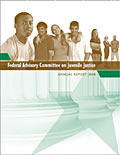 FACJJ's 2008 annual report was released in January. Both the annual report and OJJDP Responses to the 2008 FACJJ Recommendations Report to the OJJDP Administrator are available on the FACJJ Web site.
FACJJ's 2008 annual report was released in January. Both the annual report and OJJDP Responses to the 2008 FACJJ Recommendations Report to the OJJDP Administrator are available on the FACJJ Web site.
FACJJ meetings are public and anyone may register to attend and observe. For additional information, visit FACJJ's Web site.